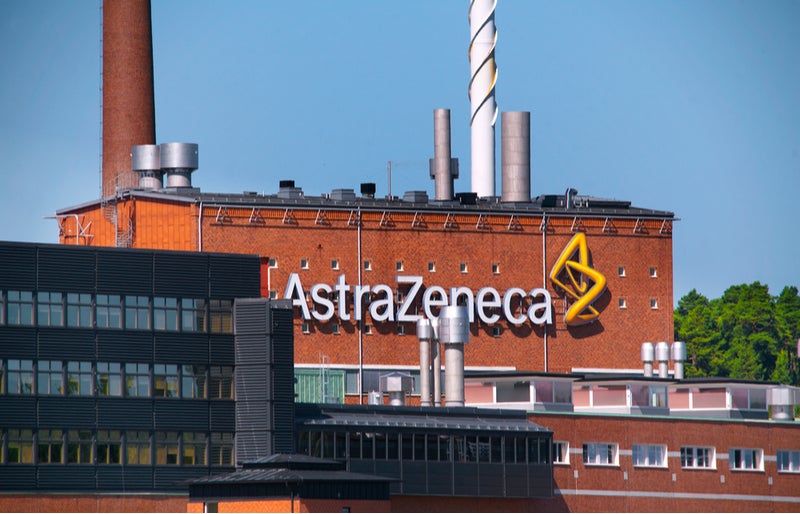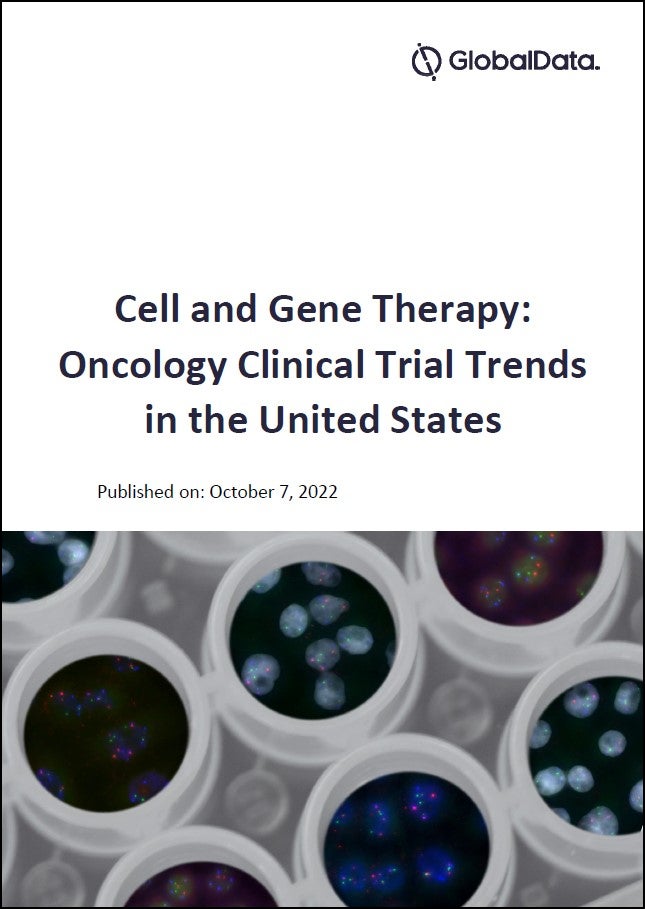AstraZeneca’s Tagrisso (osimertinib) is likely to see an uptick in uptake following final overall survival (OS) results from the Phase III Flaura study in first-line (1L) EGFR-mutated non-small cell lung cancer (NSCLC) patients, particularly outside the US.
While Tagrisso has become the 1L standard of care (SOC) in the US, other countries have often continued to prioritise other EGFR tyrosine kinase inhibitors (TKIs), and this is expected to change based on data released at the European Society for Medical Oncology (ESMO) Congress.
How well do you really know your competitors?
Access the most comprehensive Company Profiles on the market, powered by GlobalData. Save hours of research. Gain competitive edge.

Thank you!
Your download email will arrive shortly
Not ready to buy yet? Download a free sample
We are confident about the unique quality of our Company Profiles. However, we want you to make the most beneficial decision for your business, so we offer a free sample that you can download by submitting the below form
By GlobalDataAn EGFR mutation refers to a mutation (damage) to the portion of the DNA in a lung cancer cell which carries the “recipe” for making EGFR (epidermal growth factor receptor) proteins. A TKI is a type of targeted therapy that identifies and attacks specific types of cancer cells while causing less damage to normal cells.
Most interviewed experts were in favour of making Tagrisso the 1L drug of choice for all eligible patients, especially because not all would have the chance to receive it in the second line (2L), due to either lack of T790M mutation testing required for Tagrisso use or death. The updated OS data would be especially significant in aiding Tagrisso uptake over other EGFR TKIs in ex-US regions, where Tagrisso use is considered alongside other drugs of the same class. Yet, while one expert agreed the OS improvement seen in Flaura was significant, he still emphasised the need for additional trials to elucidate the optimal sequence of TKIs for EGFR-mutated NSCLC.
Experts also noted the significance of ongoing studies exploring immunotherapy in the 2L setting, because Tagrisso resistance in 2L will be an unmet need.
Tagrisso is AstraZeneca’s best-selling oncology drug, with worldwide revenues touching $1.86bn in 2018. Other approved 1L EGFR TKIs include AstraZeneca’s Iressa (gefitinib), Roche /Astellas Pharmaceuticals’ Tarceva (erlotinib) and Boehringer Ingelheim’s Gilotrif (afatinib). The 2018 revenues from Iressa and Tarceva were $518m and $268m, respectively, according to company reports.
Tagrisso is estimated to earn $6.3bn revenues in 2025, while Iressa and Tarceva revenues are projected to be $405m and $83m, respectively, as per GlobalData.
AstraZeneca did not respond to a request for comment.
Tagrisso likely to be preferred 1L option
Starting therapy with a first- or second-generation EGFR TKI and using Tagrisso on resistance when specific secondary mutations emerge is an existing strategy in the field, said a European oncologist. However, it can be a risky one, since less than a quarter of patients who start on first- or second-generation TKIs eventually get Tagrisso, because the rest either progress or die, he added. And while there are patients who benefit from 2L Tagrisso, there is no method to identify these patients, said a US-based oncologist. Moreover, the ability to identify T790M secondary mutations — against which Tagrisso is effective and approved for in 2L — depends on a technique that is not always easily available, said Dr Pilar Garrido, associate professor, Medical Oncology at Universidad de Alcalá, Madrid, Spain, but did not comment on Flaura’s uptake impact.
Yet, Dr Federico Cappuzzo, director, Medical Oncology, AUSL della Romagna, Ravenna, Italy, said that further investigation is still needed to assess the best sequence. This news service reported on 3 October that an investigator-led study Cappuzzo is involved in will start in coming months to compare a sequence of Tagrisso followed by Pfizer’s approved TKI Vizimpro (dacomitinib) to the two drugs in reverse order. While based on the data so far Tagrisso is the best agent to use in clinical trials, additional trials are needed that explore sequencing strategies to optimize a survival benefit, said Cappuzzo.
Tagrisso first received accelerated approval in November 2015 for use in patients with EGFR T790M mutation-positive NSCLC who progressed on or after EGFR TKI therapy. The drug was subsequently approved as a 1L therapy in EGFR-mutated NSCLC by the FDA and the European Commission in April and June 2018, respectively.
For clinicians, patients and health authorities, the Flaura OS results are very relevant, added Garrido. Data presented at ESMO from Flaura (NCT02296125) showed that the median OS with Tagrisso was 38.6 months versus 31.8 months with Tarceva or Iressa in the control arm, with a hazard ratio of 0.799. Iressa and Tarceva were approved for 1L treatment of EGFR-mutated NSCLC in July 2015 and May 2013, respectively.
In the US, the field has already moved toward the widespread use of Tagrisso in 1L, and the updated ESMO data does not change the SOC, said Dr Christopher Azzoli, director, Thoracic Oncology, Brown University, Providence, Rhode Island. Even though it was not final data, a survival benefit was observed with Tagrisso in the previous publication of Flaura data, said the US oncologist, on why 1L use is acceptable in the US. In 2018, The New England Journal of Medicine published Flaura results showing Tagrisso had an 8.7-month progression-free survival improvement over Iressa or Tarceva, and the survival rate at 18 months was 83% with Tagrisso versus 71% with Iressa or Tarceva (Moria et al.; N Engl J Med 2018; 378:113-125).
Yet, Tagrisso 1L use is not standard in a lot of countries outside the US, said the US oncologist. The updated Flaura data should mean that Tagrisso replaces the older standards, said the European oncologist.
Nonetheless, Azzoli noted that Tagrisso costs more for access in resource-poor countries and they don’t have the opportunity to use Tagrisso in 1L. Patients in such countries often do not have insurance and have to pay for treatment themselves, which financially is challenging, he explained. Hopefully, payer authorities in these countries will consider the OS improvement in granting access to Tagrisso for 1L therapy, said the US oncologist.
Next line of treatment unknown
Now that most patients receive Tagrisso in 1L, the key unmet need is for therapy after resistance develops to Tagrisso, said Azzoli. Currently, chemotherapy is the SOC after Tagrisso, noted the US and European oncologist.
It remains to be seen if an immunotherapy/chemotherapy will be more efficacious then chemotherapy alone post-Tagrisso, said the European oncologist. Being able to use immunotherapy in that setting could be especially significant because patients who progress on Tagrisso would likely be naïve to chemotherapy/immunotherapy combinations, said Metro. A Phase III trial (NCT03515837) sponsored by Merck is evaluating chemotherapy with or without Keytruda (pembrolizumab) in EGFR-mutated NSCLC patients who have either T790M mutations or failed on TKIs including Tagrisso and have T790M mutations or failed 1L Tagrisso regardless of T790M mutations. An investigator-sponsored Phase II trial (NCT04099836) will explore Roche’s Tecentriq (atezolizumab)/Avastin (bevacizumab) in patients with progressive disease after Tagrisso.
Moreover, checkpoint inhibitor monotherapy studied in EGFR-mutated patients after 1L TKIs have had low response rates and survival, said Metro. A statistically significant benefit was not observed in the Phase III Checkmate 057 study (NCT01673867) with Bristol-Myers Squibb’s Opdivo (nivolumab) among 82 EGFR-mutant NSCLC patients post platinum chemotherapy, even though the study showed a benefit in the overall population over docetaxel (Borghaei et al.; N Engl J Med 2015; 373:1627-1639). The EGFR-mutant NSCLC patients were allowed to receive a line of TKI therapy before being enrolled on the study. Checkpoint inhibitor approvals of Keytruda and Opdivo combined with Yervoy (ipilimumab) excluded patients with EGFR mutations.
AstraZeneca’s market capitalisation is £90.7bn ($114.8bn).
by Manasi Vaidya in New York
Manasi Vaidya is a Senior Reporter for Clinical Trials Arena parent company GlobalData’s investigative journalism team. A version of this article originally appeared on the Insights module of GlobalData’s Pharmaceutical Intelligence Center. To access more articles like this, visit GlobalData.











Related Company Profiles
Insights Co Ltd
Brown University
MEDICAL ONCOLOGY, LLC
SOC, LLC
AUSL della Romagna